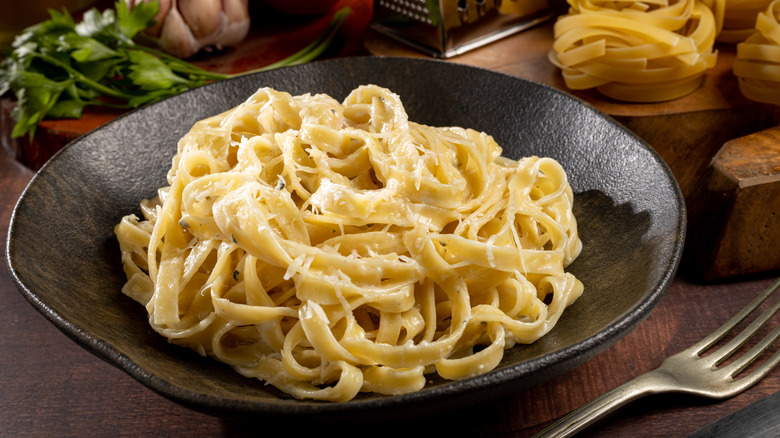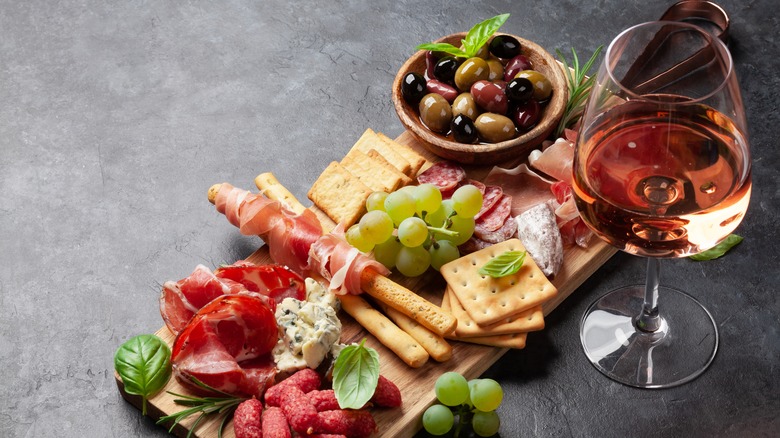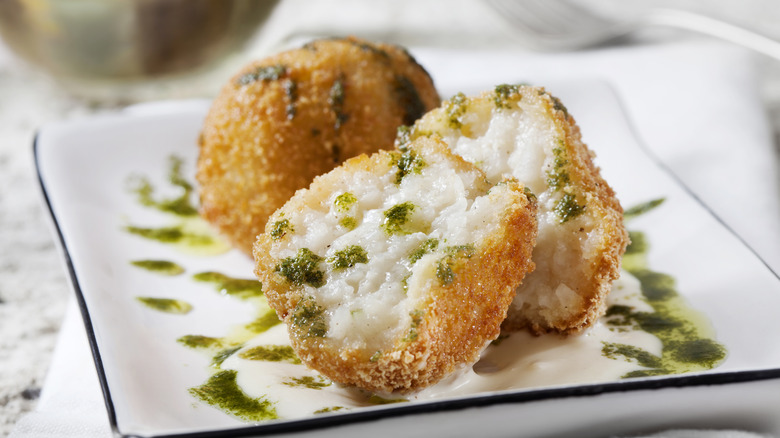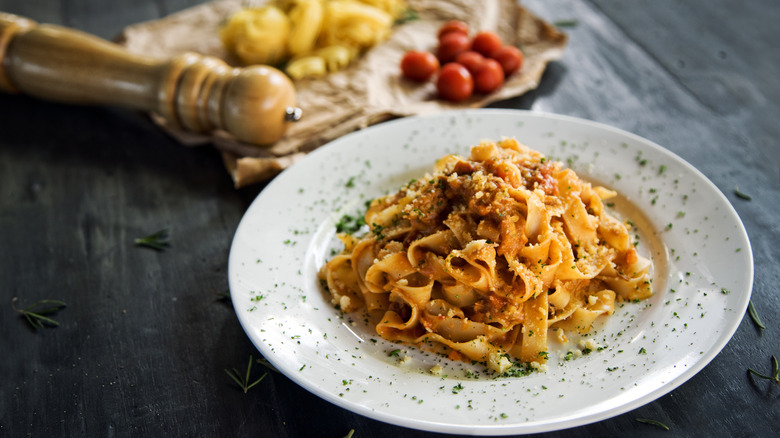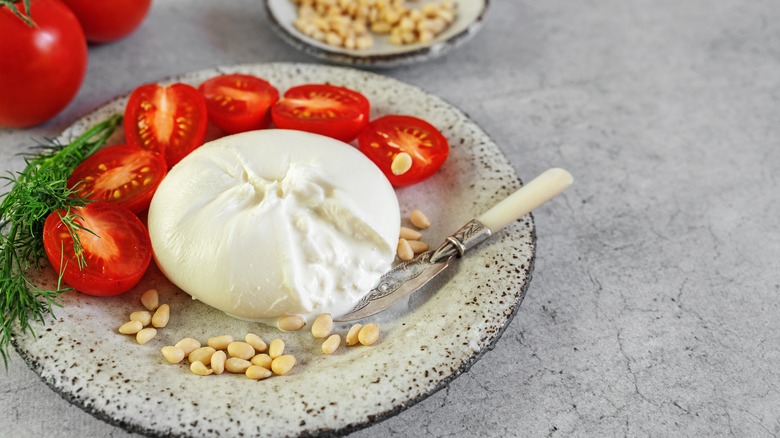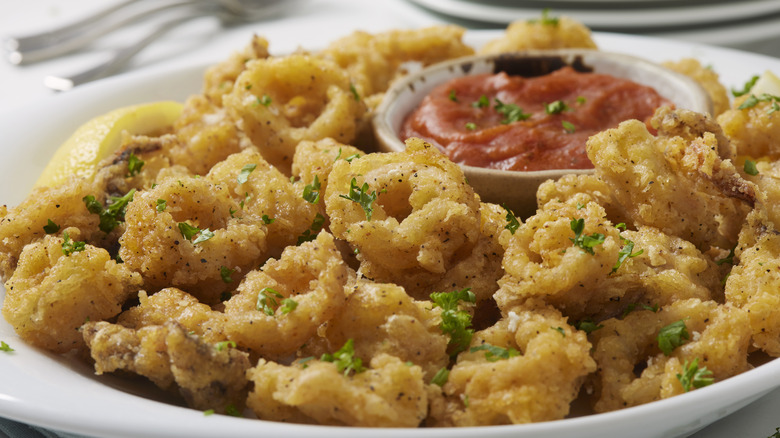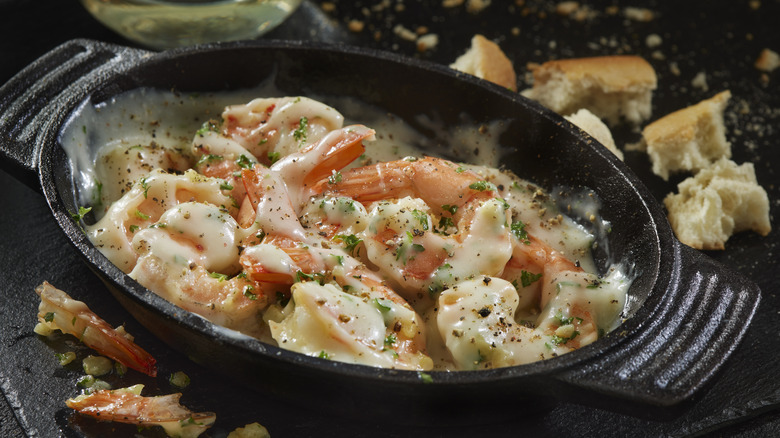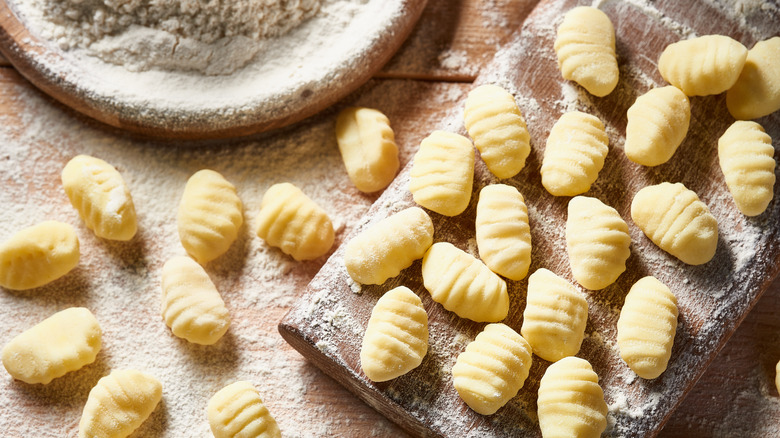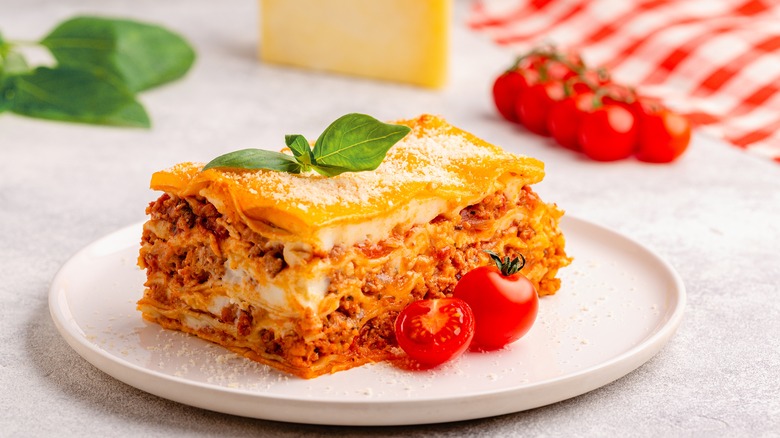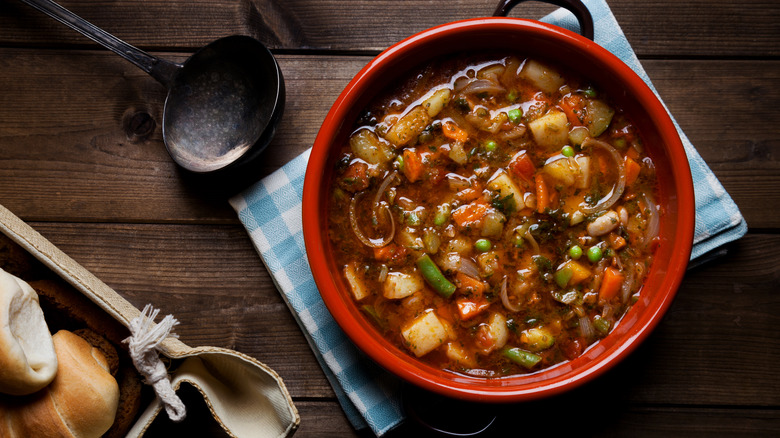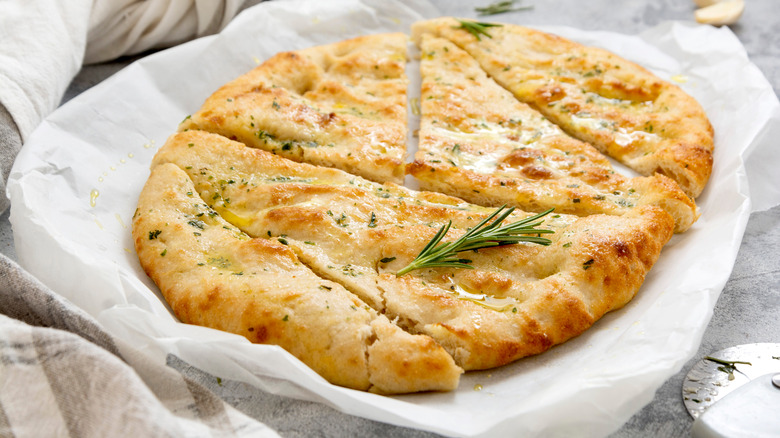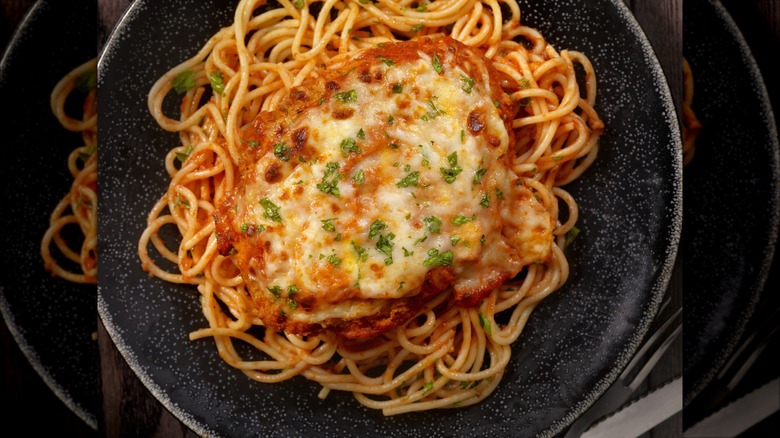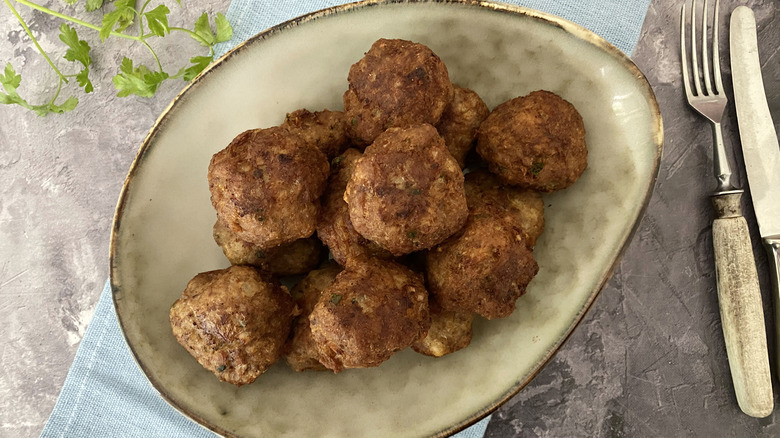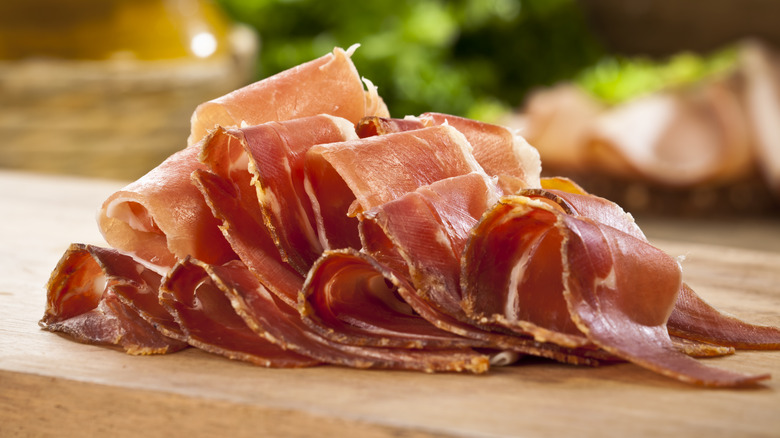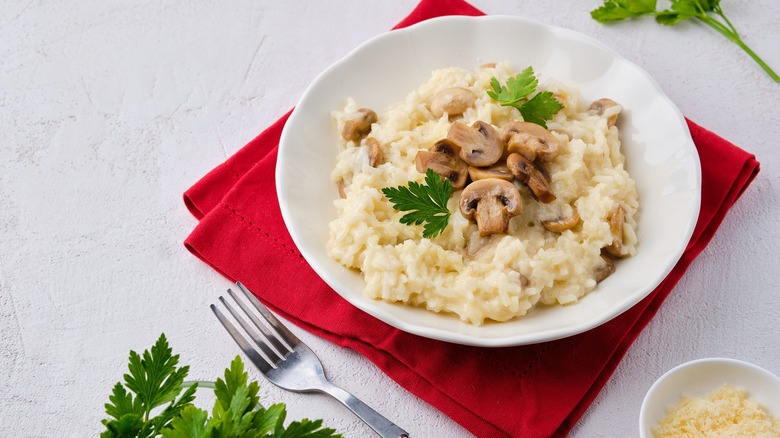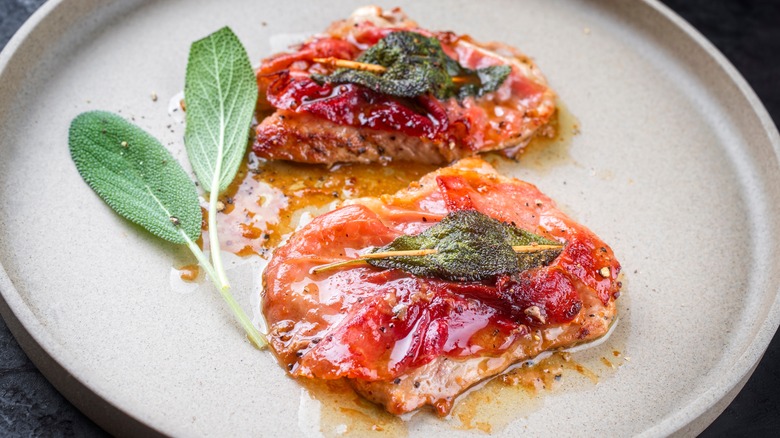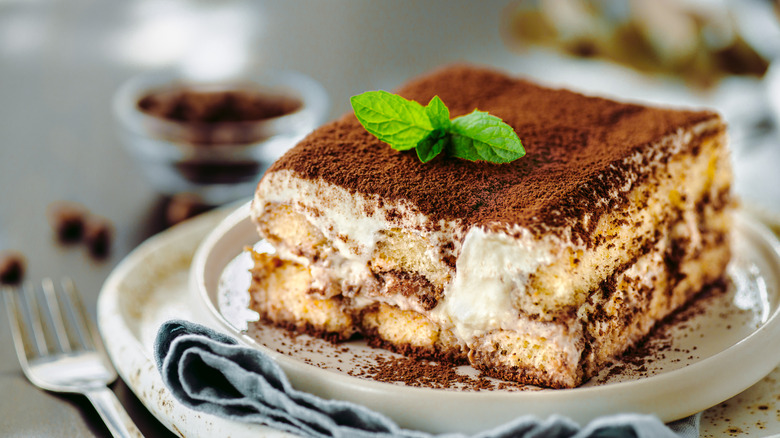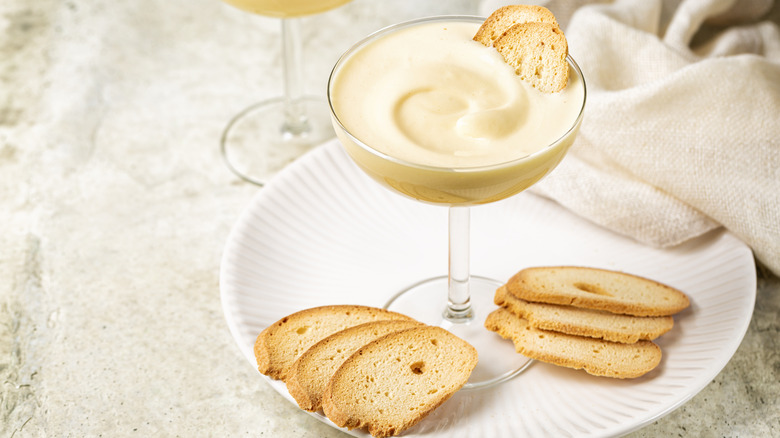25 Essential Words You Should Know When Dining At An Italian Restaurant
To many, Italian food is more than just a type of cuisine. It is an art form. What's not to love about delicious pasta, sauces, meats, and cheeses? However, ordering Italian food can be complicated if you aren't familiar with the language. The names of many popular dishes are, naturally, in Italian. So, if you don't know what arancini, pana, bolognese, polpette, or burrata mean, how are you possibly going to know what to order the next time you visit an Italian restaurant? Sure, you could ask the waiter what the names of the dishes on the menu mean, but do you want to do this for several items?
Don't fret. We're here to help. We've rounded up a list (in alphabetical order) of some of the most popular — and most delicious — words and phrases you'll want to know the next time you dine at an Italian restaurant. Make sure you're prepared to order one of your favorite, or perhaps, new favorite, dishes.
1. Affogato
If you've never heard of affogato, you'll want to try it after reading about it now. It is a cross between a drink and a dessert, made by combining espresso and ice cream.
Once you understand that affogato means "drowned," you'll understand why this treat earned its name. An espresso shot is poured over a scoop of ice cream, effectively drowning it. It is best enjoyed when the espresso shot is poured over the ice cream immediately before it is served so that the ice cream is still semi-solid when you enjoy it.
2. Alfredo
You've likely heard the term Alfredo before. You may have even tried chicken or shrimp Alfredo, but do you know what it means? Alfredo sauce was invented in 1908 by restauranteur Alfredo di Lelio and is a creamy, white sauce featured in many Italian dishes. While you're most likely to see it paired with pasta, it may also be added to a pizza instead of red sauce or used to top a piece of meat.
Alfredo sauce is so creamy and delicious because of its ingredients (hint: it isn't especially healthy). The flavors of heavy cream, butter, and parmesan cheese combine to make this delectable sauce.
3. Antipasto
While you may hear the term antipasto and think it refers to a kind of pasta, it is more of an appetizer. Meaning "before the meal," an antipasto platter typically consists of a few different items. Depending on the restaurant you order from, you may find some combination of sliced deli meats, olives, marinated red peppers or artichoke hearts, sliced or shaved cheese, nuts, or bread on the platter.
In addition to serving as an appetizer to a meal, an antipasto platter is often artfully put together with an emphasis on presentation. Taste, texture, and color are all considered when deciding which foods to add to the plate.
4. Arancini
Often served as an appetizer or snack, arancini is another Italian food you'll probably want to try. It is made by deep-frying balls of breaded risotto. The resulting treat is smooth on the inside with a slightly crunchy exterior.
Arancini was first created more than 1,000 years ago. Today, you'll find different takes on this classic dish, including versions that add meat, sauce, cheese, mushrooms, pistachios, and various herbs. The one constant ingredient, however, is rice.
5. Bolognese
Bolognese,cream (pronounced bow-luh-NAYZ, not boh-log-NESE,) is a ragù sauce whose name is associated with the city of Bologna, Italy. It differs from a traditional tomato sauce because it typically contains more vegetables, like celery, onions, and carrots. White wine and milk are also added to the sauce, giving it a distinct taste and a creamier texture than regular sauce.
Different meats can be added to a Bolognese sauce, with veal, beef, and pork being among the most common. Another difference between Bolognese sauce and other spaghetti sauces is that it is most commonly served with thicker pasta, such as tagliatelle or fettuccine.
6. Bomboloni
If you're in the mood for dessert the next time you're dining at an Italian restaurant, prepare to get excited if you see bomboloni on the menu. Their name alone is enough to catch your attention, but what sets them apart is the way they taste. Bomboloni are a special type of Italian donut that is deep-fried, coated in sugar, and then filled.
While there are many dessert variations of bomboloni, which may be filled with custard or jams, there are also savory versions. These are often filled with salami, different types of cheese, and more.
7. Burrata
Burrata's taste and texture are as smooth as its name. It is a creamy and utterly delicious Italian cheese best enjoyed at room temperature. The cheese is made by hand using milk from buffalos in Apulia, Italy.
At first glance, burrata may look similar to fresh mozzarella, another delectable Italian cheese. However, some key differences exist between mozzarella and burrata cheese, one of the most important being the extra creamy center in burrata.
8. Calamari
Calamari is the Italian word for squid and is another dish you'll often find on the menu at an Italian restaurant. Most commonly, you'll find calamari listed as an appetizer, and it is typically served fried. Marinara sauce or another dip is often served alongside the crispy and scrumptious squid.
While many associate calamari with the fried appetizer, there are other Italian dishes that may also feature squid. You may also see it added to pasta, rice, or soup dishes.
9. Gamberetti alla crema
The literal translation of gamberetti alla cream is "creamed shrimp," and that is a pretty accurate description of this Italian dish. Peeled and deveined shrimp are cooked in butter before being smothered with a rich sauce made of heavy cream, butter, garlic, and other seasonings.
This delectable Italian recipe was originally made in Venice, a coastal city with plenty of fresh seafood. If you like shrimp, and you happen to spot it on an Italian restaurant menu, you'll want to add it to your list.
10. Gelato
Consider yourself lucky if you find an Italian restaurant that serves high-quality gelato. While it is often mistaken for ice cream, and certainly has much in common with this other frozen treat, gelato is not the same as ice cream.
Gelato has a much richer flavor than ice cream. While ice cream is made with a lot of cream, gelato is crafted with less cream and more milk. This gives it a denser texture as well. The frozen treat can be found in several flavors, so you'll want to experiment to find your favorites.
11. Gnocchi
Gnocchi are scrumptious little dumplings made with mashed potatoes, eggs, and flour. Wheat or semolina flour may be used depending on the specific recipe. Some variations can also feature cheese or herbs.
The soft dumplings are typically served with sauce. You may notice they have little ridges along the side, designed to help more delicious sauce adhere to the potato pasta for flavorful bites.
12. Grappa
Grappa is a special type of alcoholic drink made using grapes leftover from winemaking. True Grappa hails directly from Italy, where the grapes' leftover seeds, skins, stems, and pulps are fermented to create a strong spirit.
If you're offered Grappa at an Italian restaurant, it won't be before or during the meal. Grappa is traditionally served after the meal to help individuals digest their food. Depending on where you order the beverage, it may come in a shot glass or a stemmed nosing glass.
13. Lasagna
OK, you probably already know what lasagna is. But do you really understand everything that makes this traditional dish so special? Unlike many other pasta dishes, which feature short or skinny noodles mixed with sauce, lasagna is a layered dish that uses long, rectangular noodles.
Traditional recipes feature layers of noodles along with marinara or meat sauce, mozzarella, and ricotta cheese. Sometimes, other sauces or cheeses may be added to the mix. For example, some varieties add pesto, radicchio, or béchamel sauce to the lasagna for a unique or regional take on a classic.
14. Minestrone
You may occasionally hear minestrone called "poor man's soup." This saying dates back to the creation of the dish, when peasants in Italy would save up the vegetables leftover from other meals and then use them to make soup. There are still many different recipes for minestrone that evolved from the various concoctions made solely based on what was available.
Tomatoes, carrots, celery, garlic, onions, and pasta are among some of the ingredients that are standard across many recipes. Still, you may also find menu offerings incorporating beans, squash, peas, potatoes, and more.
15. Pana
Is a true Italian meal really complete without bread? Perhaps not, and that's precisely where pana (bread) comes in. There are several different types of Italian bread, including a few that you're likely to come across in an Italian restaurant. Focaccia is a flatter bread that is made using olive oil and baked in a sheet pan instead of a loaf pan.
Ciabatta is another popular choice. The rustic loaves have a crispy outside and a chewy center. You may see ciabatta served with the bread service, but it can also be used to make a delicious Italian sandwich.
16. Panna cotta
While panna cotta might sound similar to pana, the two are very different. While pana is bread, panna cotta is a smooth and silky Italian custard. It is made with cream (sometimes milk and cream), gelatin, and sugar. The gelatin allows it to take the shape of the container in which it is prepared. Sometimes, it is served inside the bowl, while other times, it may be removed from the mold and served on a plate.
The panna cotta base may be flavored with caramel or vanilla. Once set, fruit, chocolate sauce, or other sweet additions may be added before serving. If you see panna cotta on the dessert menu at an Italian restaurant, plan the rest of your meal to ensure you have room for something sweet before heading back home.
17. Parmigiana
The next time you visit an Italian restaurant, you may be lucky to find vitello alla parmigiana, pollo alla parmigiana, or melanzane alla parmigiana on the menu. Also known as veal parmesan, chicken parmesan, or eggplant parmesan, these are cheesy, saucy, and mouth-watering entrees. They are made by flouring and frying the meat (or eggplant), topping them with marinara sauce and cheese, and baking them in the oven.
Traditionally, parmigiana was made with just eggplant. This recipe's exact origins are unclear, though you can find some different takes on it in various regions of Italy. After Italian immigrants introduced the dish, variations made with breaded chicken or veal became popular in the United States and other countries.
18. Polpette
Polpette translates to "meatballs." As Americans, we may immediately think of spaghetti and meatballs when we hear Italian food. However, if you go to a traditional Italian restaurant, you won't find spaghetti and meatballs on the list.
In Italy, polpette may be served with some sauce, but they are not used to top pasta. Instead, they are generally used as an appetizer. The recipe can vary depending on the region, and the little meatballs may be baked, fried, served in a red or white wine sauce, and more.
19. Prosciutto
Prosciutto may mean dried ham in Italian, but it should not be confused with the regular deli ham you can buy at the grocery store. This special meat is sourced from only the pigs' hind legs. One variety of the meat, prosciutto cotto, is cooked while prosciutto crudo is not cooked, but is aged and cured, often for years. The length of time the meat cures, along with the specific seasonings that are added during the process, will all impact the overall taste of the prosciutto.
Prosciutto di Parma is highly regarded as one of the best varieties. It can only be made in Emilia Romagna using a specific type of pigs and following strict guidelines regarding air quality and curing time.
20. Risotto
Risotto is a smooth, creamy, and cheesy rice dish. When preparing risotto, the rice is cooked more slowly, which causes the starches to be released. This process results in a very smooth sauce covering the grains of rice.
You'll likely find many varieties of risotto on Italian menus. Some may feature different types of cheeses, various seasonings, and proteins. Some proteins you might find include shrimp, scallops, or sausage. Risotto may also be served as a side, without protein.
21. Sfogliatelle
Sfogliatelle (pronounced sfow-lee-uh-TEH-lay) is a flaky Italian pastry that can offer a sweet ending to your dining experience. While sfogliatelle is thought to have been accidentally created by a nun at the Santa Rosa in Conca dei Marini convent on the Amalfi Coast in the 17th century, today, the treats can be found across Italy and several other countries.
Sfoglia, which means layers, seems like a fitting name for these pastries, consisting of thin layers of flaky dough. The real treat, however, lies inside these layers, where you'll find sweet ricotta cheese and semolina. Yum!
22. Saltimbocca
Saltimbocca (pronounced SAAL-tuhm-bow-kuhis) is another traditional Italian recipe you'll be lucky to find on a restaurant menu. Although it can be made with pork, beef, or chicken, it is most commonly made with veal.
Saltimbocca is made by wrapping very thin veal (or chicken, pork, or beef) cutlets with prosciutto. The wrapped meat is then pan fried, which takes only a few minutes because everything is thinly sliced. Once the meat is finished, it is removed from the pan, where a delicious white wine sauce is whipped up to serve atop the crispy, prosciutto-wrapped cutlet.
23. Tiramisù
Tiramisù is another Italian word you've probably heard but may not know exactly what it means. Tiramisù translates to "pick me up," and thanks to espresso in its ingredients list, this decadent, layered dessert can do just that.
Tiramisù is traditionally made with ladyfingers, though some versions use sponge cake. The dessert also features layers of mascarpone cheese mixed with sugar and eggs and espresso-dipped ladyfingers.
24. Vino
The next time you dine at an Italian restaurant, you may be looking for the best wine to pair with oysters, lasagna, parmigiana, or even with pizza. Fortunately, the Italian word for wine is simple and easy to remember. Just ask your waiter or waitress for a glass of vino.
If you're lucky, the restaurant you're visiting will have a few traditional Italian wines. Prosecco, Chianti, Franciacorta, or Pinot Grigio are some of the wines you may want to pair with your meal.
25. Zabaglione
Zabagli-what? Zabaglione (pronounced zuh-buh-glee-OWN) may sound like a strange word, but trust us, you'll want to remember it to order it the next time you spot it on a menu.
Three basic ingredients — wine, egg yolks, and sugar — combine to create a special treat for your tastebuds. Zabaglione is made by whisking the ingredients together over a bath of simmering water. After a few minutes of whisking over the heat, the ingredients emulsify, creating a thick foam that may be served over a pastry or a slice of cake or combined with some heavy whipping cream. As you can probably guess, the type of wine used to make zabaglione will greatly impact how it tastes, so you may find many variations of this recipe at different restaurants.


